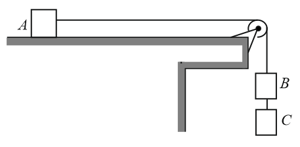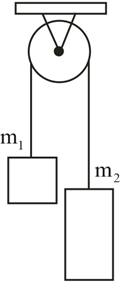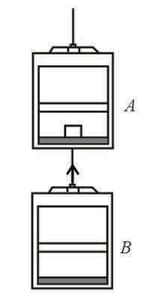A lamp hangs vertically from a cord in a descending elevator, that decelerates at .
(a) If the tension in the cord is , what is the lamp's mass?
(b) What is the cord's tension, when the elevator ascends with an upward acceleration of ?

Important Questions on Force and Motion-I
An elevator cab that weighs moves upward. What is the tension in the cable, if the cab's speed is
(a) increasing at a rate of .
(b) decreasing at a rate of .
In elevator cabs and are connected by a short cable and can be pulled upward or lowered by the cable above cab . Cab has mass ; cab has mass. A box of catnip lies on the floor of cab . The tension in the cable connecting the cabs is . What is the magnitude of the normal force on the box from the floor?
In a block of mass is pulled along a horizontal frictionless floor by a cord that exerts a force of magnitude at an angle . What is the magnitude of the block's acceleration?
The force magnitude is slowly increased. What is its value just before the block is lifted (completely) off the floor?
What is the magnitude of the block's acceleration just before it is lifted (completely) off the floor?

In the figure shown below three ballot boxes are connected by cords, one of which wraps over a pulley having negligible friction on its axle and negligible mass. The three masses are and When
the assembly is released from rest,
(a) what is the tension in the cord connecting and
(b) how far does move in the first (assuming it does not reach the pulley)?

In the figure shown below shows two blocks connected by a cord (of negligible mass) that passes over a frictionless pulley (also of negligible mass). The arrangement is known as at wood's machine. One block has mass the other has mass. What are (a) the magnitude of the blocks' acceleration and (b) the tension in the cord?


